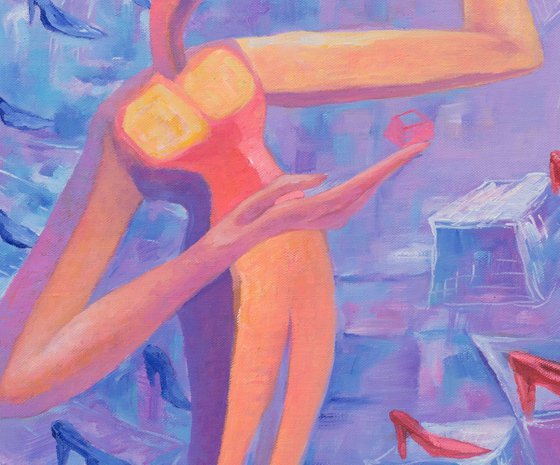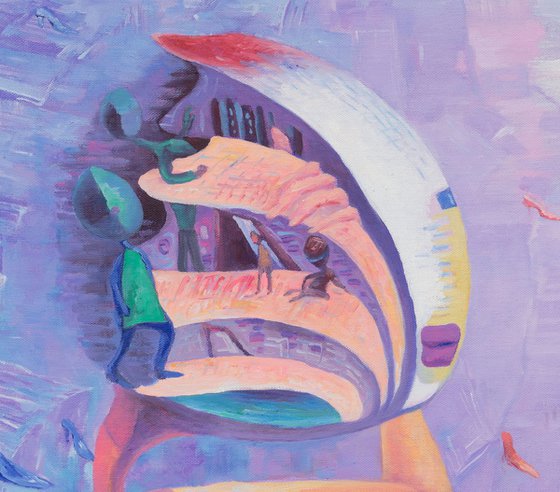- By medium
- By subject
- By budget
- Sales
- Gift cards
- Discover all art
- Artists
- Editors’ picks
- Ideas
Original artwork description:
"Metaverse II" by Xu Bin is a stunning and thought-provoking oil painting that depicts a fictional scene in the Metaverse, an imagined virtual space that has captured the imagination of many in recent years. The painting depicts a female robot out shopping, trying to decide which pair of shoes to buy. What is particularly interesting about the painting is the various layers of meaning that it conveys, making it a rich and complex work of art.
At first glance, the painting appears to be a simple depiction of a robot out shopping for shoes. However, upon closer inspection, it becomes clear that there is much more going on here. The robot's brain has been drawn to look like an open library, with many people learning and exploring inside. This emphasizes the idea that artificial intelligence provides a new way for human learning and exploration. With the help of AI, humans can gain a faster and deeper understanding of knowledge in various fields and promote the development of human civilization.
The robot's left hand is resting on her brain, indicating that she is deep in thought about which pair of shoes to buy. This suggests that the robot is not just a machine, but has the ability to think and act independently. The fact that the robot is out shopping for shoes also suggests that robots already have a life similar to human beings. In this fictional scenario, robots have become life forms with artificial intelligence.
The booth where the shoes are displayed is in the shape of a keyboard key, hinting at the idea that robots have a unique aesthetic different from humans. This emphasizes the difference between the robot society in the Metaverse and the human society in the real world. The shoes themselves are depicted in various styles, highlighting the diversity of preferences and tastes that exist even within the world of robots.
On the tip of the robot's right finger is a delicate red toy in the shape of a keyboard key. This toy holds important meaning in the painting. It represents the creator of artificial intelligence - human beings - and their values. The fact that the robot holds the toy on her fingertips shows how much she values human values. At the same time, it also shows that robots have human emotions. This hints at a new possibility that robots and humans can coexist and reminds humans not to forget the values they hold as creators of artificial intelligence.
Overall, "Metaverse II" is a captivating work of art that explores the relationship between artificial intelligence and humans. It suggests a future full of hope and possibility, where robots and humans can live and work together in harmony. Xu Bin's painting is a reminder that we should embrace technology and use it to further our understanding of the world, but we should also remember to remain true to our values as human beings.
Materials used:
oil paints
Metaverse II - One Day I Will Be Like This (2022)
Oil painting
by Xu Bin
£4,089.55
- Oil painting on Canvas
- One of a kind artwork
- Size: 80 x 100 x 3cm (unframed) / 80 x 100cm (actual image size)
- Ready to hang
- Signed on the front
- Style: Surrealistic
- Subject: Abstract and non-figurative
Original artwork description
"Metaverse II" by Xu Bin is a stunning and thought-provoking oil painting that depicts a fictional scene in the Metaverse, an imagined virtual space that has captured the imagination of many in recent years. The painting depicts a female robot out shopping, trying to decide which pair of shoes to buy. What is particularly interesting about the painting is the various layers of meaning that it conveys, making it a rich and complex work of art.
At first glance, the painting appears to be a simple depiction of a robot out shopping for shoes. However, upon closer inspection, it becomes clear that there is much more going on here. The robot's brain has been drawn to look like an open library, with many people learning and exploring inside. This emphasizes the idea that artificial intelligence provides a new way for human learning and exploration. With the help of AI, humans can gain a faster and deeper understanding of knowledge in various fields and promote the development of human civilization.
The robot's left hand is resting on her brain, indicating that she is deep in thought about which pair of shoes to buy. This suggests that the robot is not just a machine, but has the ability to think and act independently. The fact that the robot is out shopping for shoes also suggests that robots already have a life similar to human beings. In this fictional scenario, robots have become life forms with artificial intelligence.
The booth where the shoes are displayed is in the shape of a keyboard key, hinting at the idea that robots have a unique aesthetic different from humans. This emphasizes the difference between the robot society in the Metaverse and the human society in the real world. The shoes themselves are depicted in various styles, highlighting the diversity of preferences and tastes that exist even within the world of robots.
On the tip of the robot's right finger is a delicate red toy in the shape of a keyboard key. This toy holds important meaning in the painting. It represents the creator of artificial intelligence - human beings - and their values. The fact that the robot holds the toy on her fingertips shows how much she values human values. At the same time, it also shows that robots have human emotions. This hints at a new possibility that robots and humans can coexist and reminds humans not to forget the values they hold as creators of artificial intelligence.
Overall, "Metaverse II" is a captivating work of art that explores the relationship between artificial intelligence and humans. It suggests a future full of hope and possibility, where robots and humans can live and work together in harmony. Xu Bin's painting is a reminder that we should embrace technology and use it to further our understanding of the world, but we should also remember to remain true to our values as human beings.
Materials used:
oil paints
Returns and refunds
We want you to love your art! If you are not completely satisfied with your purchase you can return it free within 14 days, no questions asked. Learn more





